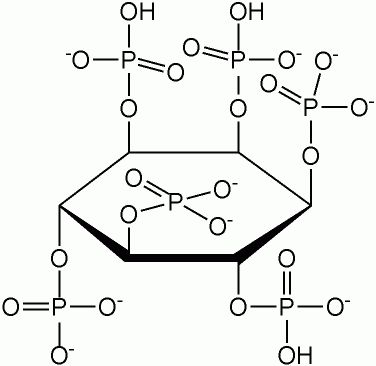Food-Info.net> Questions and Answers > Food products > Legumes and beans
What is phytic acid (phytate) ?
Phytic acid (known as inositol hexaphosphate (IP6), or phytate) is the principal storage form of phosphorus in many plant tissues, especially in the grass family (wheat, rice, rye, barley etc) and beans. Phosphorus in this form is generally not bioavailable to humans because humans lack the digestive enzyme, phytase, required to separate phosphorus from the phytate molecule.
 Phytate structure (Source)
Phytate structure (Source)
Phytic acid binds to important minerals such as calcium, magnesium, iron and zinc and can therefore contribute to mineral deficiencies, as the minerals are not released from the phytate and are thus unavailable to the body. For people with a particularly low intake of essential minerals, especially young children and those in developing countries, this effect can be undesirable.
A common way in developing countries to increase the bioavailability of minerals from grains and beans is using fermentation. Many bacteria possess phytase activity and by fermenting grains or beans by lactic acid bacteria the phytate is destroyed and the bioavailability of the minerals is increased.
Phytic acid recently has been studied for its potential anti-carcinogenic properties. Recent studies have indicated that phytic acid may have some preventive effect in prostate, breast, pancreatic and colon cancer. The mechanism, however, is not yet understood.
References :
- Breast-Cancer-Res-Treat. 2005 May; 91(1): 35-45
- J-Surg-Res. 2005 Jun 15; 126(2): 199-203
- Anticancer-Res. 2005 Jul-Aug; 25(4): 2891-903




